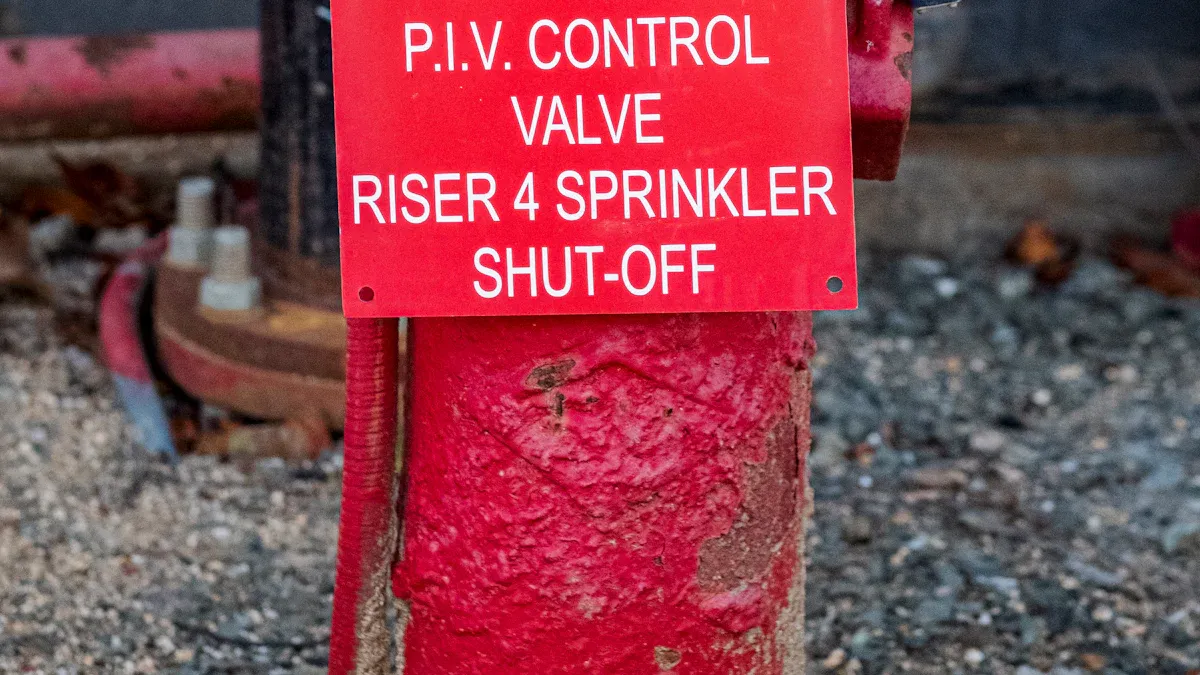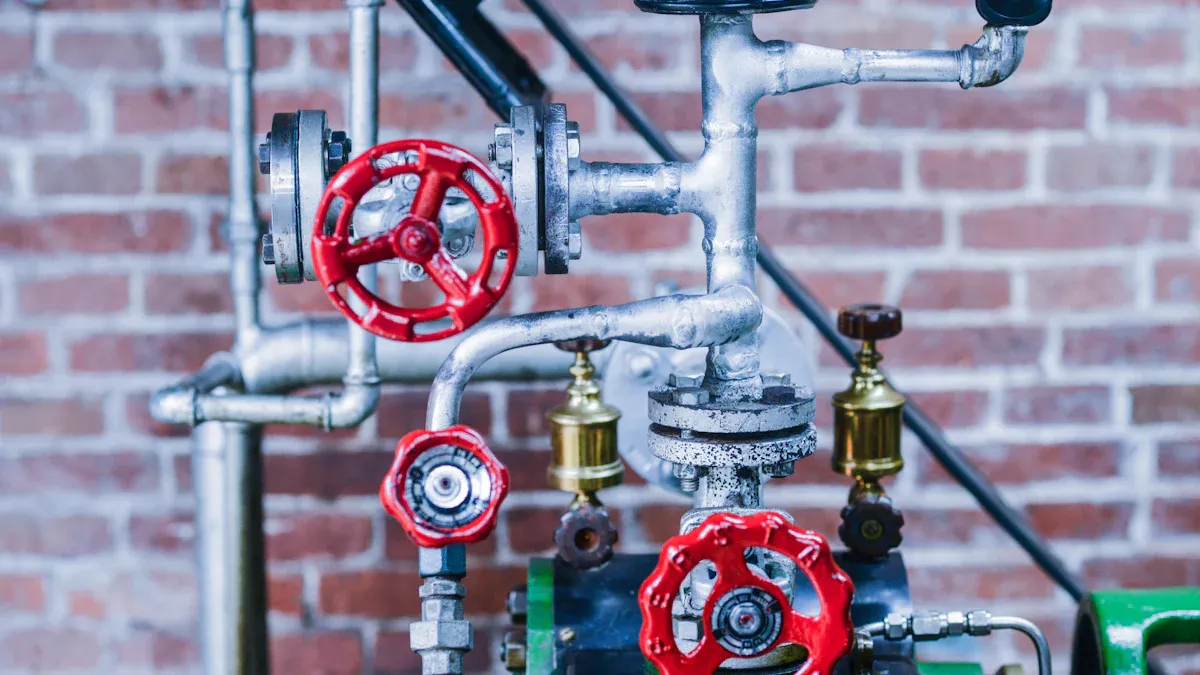
Industrial safety relies heavily on effective fire hydrant valve technology. These valves play a critical role in preventing disasters by ensuring rapid water access during emergencies. Recent advancements have driven market growth, with the global fire hydrant market projected to rise from USD 7.32 billion in 2025 to USD 10.05 billion by 2034.
Key Takeaways
- Smart systems check fire hydrants and give live updates on water pressure and flow. This helps them work well in emergencies.
- Strong materials like rust-proof metals make fire hydrant valves last longer. They can handle tough conditions and stay useful for years.
- Automatic pressure control keeps water flowing evenly in emergencies. This saves time and helps firefighters do their job better.
Smart Monitoring Systems in Fire Hydrant Valves

Overview of Smart Monitoring Systems
Smart monitoring systems are revolutionizing fire hydrant valve technology by enhancing their functionality and reliability. These systems utilize advanced sensors and wireless communication to monitor the operational status of fire hydrants continuously. By providing real-time insights into water pressure, flow rates, and valve conditions, they ensure that hydrants remain in optimal working order. This innovation addresses the critical need for proactive maintenance and rapid response during emergencies.
A recent report highlights the growing adoption of smart hydrants in the fire hydrant market. Technological advancements in these systems have significantly improved monitoring and maintenance capabilities. This progress underscores their effectiveness in enhancing the overall functionality of fire hydrant systems. As industries prioritize safety, the integration of smart monitoring systems is becoming a standard practice.
Real-Time Data Collection and Predictive Maintenance
Real-time data collection is a cornerstone of smart monitoring systems. Fire hydrants equipped with wireless sensors can transmit critical information, such as water pressure and flow rates, to centralized systems. This data enables fire departments to respond more quickly and effectively during emergencies. For example, instant alerts about pressure drops or valve malfunctions can prevent delays in firefighting efforts.
Predictive maintenance further enhances the reliability of fire hydrant valves. By analyzing data trends, these systems can identify potential issues before they escalate. Modern asset management tools streamline maintenance schedules, reducing downtime and repair costs. The integration of these technologies not only improves fire safety management but also protects lives and property.
| Key Point | Description |
|---|---|
| Real-time Data | Smart fire hydrants monitor water pressure, flow rates, and operational status. |
| Rapid Response | Instant data transmission enables faster emergency response times. |
| Life-Saving Potential | Enhanced monitoring can save lives and minimize property damage. |
Smart monitoring systems represent a significant leap forward in fire hydrant valve technology. Their ability to collect and analyze data in real time ensures that industrial facilities remain prepared for emergencies.
Advanced Materials for Fire Hydrant Valve Durability
Corrosion-Resistant Alloys and Composite Materials
The durability of fire hydrant valves has seen remarkable improvements with the adoption of advanced materials. Corrosion-resistant alloys, such as stainless steel and brass, have become essential in manufacturing these valves. These materials offer superior resistance to rust and environmental degradation, ensuring long-term reliability. Composite materials, which combine the strength of metals with lightweight polymers, further enhance the performance of fire hydrant valves in industrial settings.
The growing demand for durable fire hydrant valves reflects the need for products that can withstand extreme conditions. The industrial fire hose and hydrant accessories market is expanding rapidly, driven by the adoption of advanced materials. These innovations not only improve the lifespan of valves but also contribute to safer and more efficient firefighting operations.
Longevity and Performance in Harsh Environments
Fire hydrant valves must endure harsh environments, including high humidity, extreme temperatures, and exposure to chemicals. Selecting the right materials is critical to achieving this longevity. For instance, ductile iron valves develop a protective oxide layer, reducing the risk of corrosion. In contrast, cast iron valves are more susceptible to rust in moist conditions. Stainless steel and brass are preferred choices for mitigating corrosion-related issues.
| Performance Metric | Description |
|---|---|
| Material Durability | Brass, stainless steel, and ductile iron enhance the valve’s ability to withstand environmental challenges. |
| Corrosion Resistance | Ductile iron forms a protective layer, while cast iron is more prone to corrosion. |
| Pressure Ratings | Valves must meet or exceed system pressure requirements to ensure functionality during emergencies. |
Understanding pressure ratings is equally important. Valves designed to handle high operating pressures prevent failures during critical moments. This ensures that fire hydrant valves remain functional when they are needed most, safeguarding industrial facilities and personnel.
Automated Pressure Regulation in Fire Hydrant Valves
Functionality of Automated Pressure Regulation
Automated pressure regulation in fire hydrant valves ensures consistent water flow and pressure during emergencies. These systems use advanced mechanisms to adjust water output based on real-time demand. By maintaining optimal pressure levels, they prevent issues such as water hammering or insufficient flow, which can hinder firefighting efforts.
Modern fire hydrant valves equipped with automated pressure regulation can deliver outputs ranging from 50 to 1500 gallons per minute (GPM). They maintain pressure levels between 20 and 150 psi, ensuring adaptability to various industrial and environmental conditions. Additionally, staged pressure increases allow these valves to reach full capacity within eight seconds, minimizing delays during critical moments.
Safety and Efficiency During Emergencies
Automated pressure regulation significantly enhances safety and efficiency during emergencies. By delivering consistent pressure, these systems ensure that firefighters can rely on a steady water supply, even in high-demand situations. This reliability reduces response times and improves the effectiveness of firefighting operations.
In wildfire-prone regions, cities that invested in automated systems and regular hydrant maintenance have reported remarkable results. For instance, a city in California experienced flawless water system performance during a major fire. Hydrants delivered consistent pressure, and pre-identified weak points were reinforced before the fire season. These proactive measures reduced fire response times by 18-22% in pilot cities, showcasing the life-saving potential of automated pressure regulation.
| Feature | Details |
|---|---|
| Remotely adjustable output | 50-1500 GPM |
| Maintains optimal pressure | 20-150 psi |
| Staged pressure increases | 0-100% in 8 seconds |
| Reduced fire response time | 18-22% in pilot cities |
Automated pressure regulation in fire hydrant valves represents a critical advancement in industrial safety. Its ability to adapt to varying conditions ensures that facilities remain prepared for emergencies, safeguarding lives and property.
IoT Integration in Fire Hydrant Valve Technology
IoT-Enabled Connectivity and Remote Monitoring
IoT-enabled connectivity has transformed fire hydrant valve technology by introducing advanced monitoring capabilities. These systems utilize sensors and wireless networks to collect and transmit real-time data, ensuring that fire hydrants remain operational during emergencies. Remote monitoring allows technicians to oversee valve performance from centralized locations, reducing the need for manual inspections.
A study on urban water networks highlights the effectiveness of IoT-based systems in detecting leaks using hydrophones. These intelligent systems accurately identify real leaks while minimizing false positives and negatives. This innovation enhances the reliability of fire hydrant valves and reduces maintenance costs. Additionally, IoT-enabled systems improve water management by providing automated alerts for pressure fluctuations, flow irregularities, and maintenance needs.
Tip: IoT integration not only boosts operational efficiency but also ensures cost-effectiveness, making it a valuable investment for industrial safety.
Data-Driven Decision-Making for Industrial Safety
IoT integration empowers industries to make data-driven decisions that enhance safety protocols. Smart IoT hydrants collect critical information, such as pressure levels and water flow rates, which can be analyzed to optimize emergency response strategies. By leveraging this data, fire departments can identify weak points in the system and address them proactively.
The market for integrated intelligent fire hydrants reflects the growing demand for these advancements. Valued at USD 450 million in 2024, it is projected to grow at a CAGR of 12.5% from 2026 to 2033, reaching USD 1.2 billion by 2033. This rapid growth underscores the importance of IoT-enabled systems in improving fire response capabilities and ensuring public safety.
- Key Benefits of IoT Integration:
- Real-time monitoring and automated alerts.
- Enhanced emergency response times.
- Improved water management and system reliability.
IoT integration in fire hydrant valve technology represents a significant leap forward in industrial safety. By enabling connectivity and data-driven insights, these systems ensure that facilities remain prepared for emergencies while minimizing risks and costs.
Eco-Friendly Fire Hydrant Valve Designs

Sustainable Materials and Environmental Impact
Eco-friendly fire hydrant valve designs prioritize sustainability by incorporating materials that reduce environmental harm. Manufacturers increasingly use recycled metals and biodegradable polymers to produce valves that minimize waste and energy consumption during manufacturing. These materials not only lower the carbon footprint but also enhance the durability and performance of fire hydrant valves in industrial settings.
Several industry leaders have adopted eco-friendly practices to align with environmental goals. For instance, Hawle integrates sustainable methods into its operations, while VAG Group focuses on reducing environmental impact through innovative valve designs. These efforts highlight the growing commitment to sustainability within the fire hydrant valve industry.
| Manufacturer | Eco-Friendly Practices |
|---|---|
| Hawle | Adopts eco-friendly practices in operations |
| VAG Group | Integrates eco-friendly practices, reducing environmental impact |
By utilizing sustainable materials, manufacturers contribute to a cleaner environment while ensuring the reliability of fire hydrant valves. These advancements reflect the industry’s dedication to balancing safety and environmental responsibility.
Compliance with Green Regulations and Standards
Eco-friendly fire hydrant valve designs must comply with stringent green regulations to meet industrial and environmental standards. Governments and regulatory bodies worldwide enforce guidelines that promote sustainable manufacturing and reduce pollution. Fire hydrant valve manufacturers adhere to these standards by using non-toxic coatings, reducing water waste, and implementing energy-efficient production processes.
Compliance with green regulations not only ensures environmental protection but also enhances industrial safety. Valves designed to meet these standards often exhibit improved performance and longevity, reducing the need for frequent replacements. This approach benefits both the environment and industrial facilities by lowering operational costs and minimizing ecological impact.
The adoption of eco-friendly fire hydrant valve designs demonstrates the industry’s commitment to sustainability. By aligning with green regulations, manufacturers pave the way for safer and more environmentally responsible industrial practices.
The advancements in fire hydrant valve technology, including smart monitoring systems, advanced materials, automated pressure regulation, IoT integration, and eco-friendly designs, are reshaping industrial safety. These innovations enhance reliability, efficiency, and sustainability. Adopting these technologies ensures industries remain prepared for emergencies, safeguarding lives and assets while meeting modern safety standards.
FAQ
What are the benefits of using smart monitoring systems in fire hydrant valves?
Smart monitoring systems provide real-time data on water pressure and flow rates. They enable predictive maintenance, reduce downtime, and ensure hydrants remain operational during emergencies.
How does IoT integration improve fire hydrant valve performance?
IoT integration allows remote monitoring and automated alerts. It enhances emergency response times, optimizes water management, and reduces maintenance costs through data-driven decision-making.
Are eco-friendly fire hydrant valves as durable as traditional designs?
Yes, eco-friendly valves use advanced materials like recycled metals and biodegradable polymers. These materials ensure durability while reducing environmental impact and meeting industrial safety standards.
Note: Adopting these innovations ensures industrial facilities remain prepared for emergencies while aligning with modern safety and sustainability goals.
Post time: Apr-24-2025

